Coley’s Toxins: How the Most Effective Cancer Treatment of all Time Faded Into Obscurity
Part I: Introduction
"The first hope of therapeutic success comes with the observation of the efficiency of unaided nature to accomplish cure... These cases, rare though they be, are the sum of our hope." — Pearce A. Gould, "The Bradshaw Lecture on Cancer," 1910
Modern Spontaneous Regressions
In 2010 and 2011, two neurosurgeons from UC Davis implanted fecal bacteria in three glioblastoma patients' brains as a last-ditch effort to save their lives from a grade IV brain cancer which is so universally lethal that it is dubbed The Terminator.
Two of the patients died in roughly a month, but the third individual lived for around a year.
What sounds at first like medical malpractice is, upon closer inspection, an attempt to mimic the most consistent cancer cure ever known to mankind. Spontaneous remissions of cancer are most closely associated with a hefty feverish infection, and there is some indication that glioblastoma patients who undergo surgery and develop infections may have better outcomes than those who don’t.
While both surgeons clearly understood the risk-benefit tradeoffs and the principles of informed consent for their patients, they were forced to resign as a result:
Arthur Caplan, director of medical ethics at New York University’s Langone Medical Center, said that desperate people are especially vulnerable and need added protections.
“If you’re dying, you’re kind of like reaching out to anything that anybody throws in front of you,” said Caplan, who recently left the University of Pennsylvania’s Center for Bioethics to assume the New York post. “That’s why so many people over the years are pursuing quack cures in Mexico and all kinds of questionable treatments,” he said, speaking in general terms. “They’re not able to think straight because they’re at death’s door.”
Maybe it’s actually the authoritarians, moral busybodies, and “bioethicists” like Caplan who aren’t thinking straight.
One of the surgeons who was forced to resign unapologetically said, "If I come down with a glioblastoma, I will demand that it be done on myself.”
Spontaneous regressions associated with infections have been documented for thousands of years, and there are hundreds of such reports in the medical literature dating back to the 1700s. It is generally believed that spontaneous regression of cancer is a relatively rare event. However, patients often are lost to follow-up, and a 2008 study demonstrated that spontaneous regressions can be surprisingly frequent for small lesions, and may happen in up to 20% of breast cancer cases.
It is likely that the self-healing capacity of the human body has been dramatically underestimated, and that there are some very powerful healing forces that can be harnessed to provide profound consequences for patients. You might call this a conspiracy theory, just like natural immunity to SARS-CoV-2.
It’s difficult to prove due to my inability to access my mother’s medical records from the early 1980s, but I believe my mother experienced a spontaneous regression of histocytic lymphoma and Hodgkin’s lymphoma after a nosocomial (hospital acquired) herpesvirus infection when I was a child. I am not sure which herpesvirus she was infected with, but she had recurring bouts of ocular herpes for many years after that when she was under stress. If that was what cured her — her doctors called her a “walking miracle” they could not explain — it was a small price to pay for being able to live another 30 years.
I suspect that this sort of healing is more common than one might think. Consider the following email received by a colleague of mine a few years back. The case is eerily similar to my mother’s: spontaneous regression in a teenager with Hodgkin’s lymphoma after weeks of fever and infection with CMV, another herpesvirus!
These are not the only viruses associated with cancer regression. Polio, measles and others have been associated with regressions and some have been studied in clinical trials.
In fact, here’s a case of SARS-CoV-2 induced regression of Hodgkin’s lymphoma. Note: this is not a complete response, and probably would have worked even better for the patient if they had not offered so much “supportive care” which often means anti-pyretics counteracting the fever, too many fluids, too much food, and so on — all of which counteracts the immune response. At least they didn’t give steroids.
From Spontaneous Regression to Fever Therapy
In the summer of 1890, 18 year old Bessie Dashiell, a close friend of John D. Rockefeller Jr, traveled to Alaska and got her hand caught between the seats in a train. The wound did not heal properly and continued to irritate her. After a few months, she visited Dr. William Coley at Memorial Hospital (now Sloan-Kettering Memorial) in New York City.
Unfortunately, Coley diagnosed her with sarcoma. There was no treatment at the time, and so he amputated her arm in November, but the cancer had already metastasized. She died only a few months later in January 1891.
The death of this young cancer patient left Coley devastated, and he searched through hospital records to discover whether anyone had survived sarcoma before.
As luck turns out, Coley discovered the case history of a German immigrant with multiple tumors requiring several surgeries. The patient had recovered from cancer after the final surgery, when he suffered a post-operative skin infection of erysipelas, caused by Streptococcus pyogenes, the same bacterium that can cause diseases such as strep throat, scarlet fever, and rheumatic fever. The man was still disease-free seven years later when Coley’s tracked him down in the tenements on the East Side of Manhattan.
Coley then decided to treat another patient suffering a tonsil tumor using live S. pyogenes. It worked. The patient lived eight years and then suffered a local recurrence. But Coley eventually realized that the risks of using live bacteria were too great. The treatments had to take place in the patient’s home because the risk of infection to others in the hospital. And very much like the two brain surgeons at UC Davis, Coley tragically lost several patients to the bacterial infection itself.
But Coley soon learned that the same result could be obtained with heat-killed bacteria. He also discovered the beneficial effect of infections in tumors in the medical literature, and based on his research, he went on to add Serratia marcescens to his sterile mixture of Streptococcus pyogenes, and it worked better than anything else at the time. This second bacterium is a a cosmopolitan, opportunistic pathogen that can cause nosocomial infections, including urinary tract infections. It is everywhere in the environment, and one often sees it growing as a pink slime on the bottom of the shower curtain in more humid climates.
A sterile mixture of these two bacteria was dubbed “Coley's toxins.” Many of Bill Coley’s patients experienced lifelong remissions, and the number of durable cures produced by him and others using the toxins reached into the hundreds.
Several German physicians preceded Coley by up to 30 years in their applications of live or killed Streptococcus pyogenes to patients, but Coley was the first to systematically deploy his therapy on hundreds of patients over several decades.
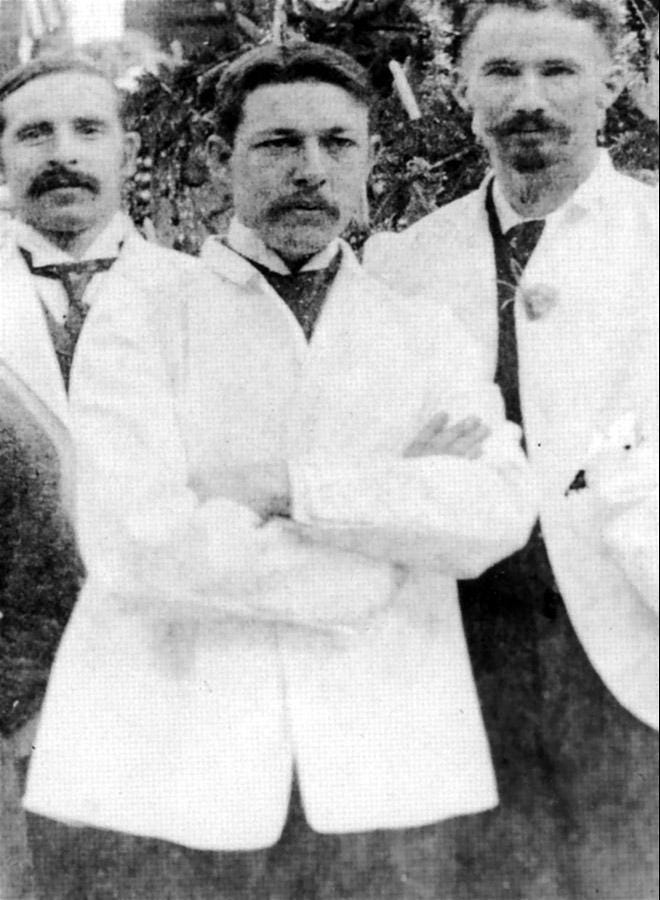
How do Coley’s toxins stack up to modern cancer therapy?
Coley is now known as the Father of Immunotherapy. While Coley’s toxins, the first immunotherapy for cancer, is fairly rudimentary from a technological standpoint, it works surprisingly well.
In 2009, two researchers from MD Anderson Cancer Center published a historical review of Coley’s toxins with this astonishing statement.1
By 1893, Coley had settled upon an admixture of heat-killed S. pyogenes and heat-killed Bacillus prodigious (now reclassified as Serratia marcescens). This fortuitous combination of Gram-positive and Gram-negative bacteria possessed a wide array of immunostimulatory properties that allowed Dr. Coley to achieve long-term cure rates unrivaled by medical science in the 73 years since his death (Table 1). Yet Coley’s treatment protocol was doomed in his own lifetime by the contemporary development of radiotherapy and the absence of a definable, mechanistic explanation for infection-mediated tumor regression [1–5]. It is the century-long search for mechanism that today defines Coley’s legacy.
The idea that Coley’s toxins fell by the wayside because we didn’t know how it worked is, however, a just-so story. It’s a bit more complex than this. Yes, there were the unknown mechanisms of action. But in addition, publications were not written according to present day standards, preparations of the toxins were unstandardized, they were used across a wide variety of cancers with different lengths of treatment and sites of injection, different levels of fever were achieved, and, last but by no means least, the therapy suffered at the hands of personal and institutional power struggles and the epistemological blindnesses of the Big Oil modern medicine mentality. All of these factors ensured that the therapy quietly faded into obscurity over a number of decades.
Coley’s toxins were also stiff-armed by the US government and the American Cancer Society for about 30 years. Eventually they were quietly removed from the ACS’s “quack list” of unproven cancer treatment methods, and are now generally acknowledged as useful even by mainstream prominent scientists in the field:
"One of the things I've come to appreciate is that many of the things that we are doing are recapitulating things that Dr. Coley did a century ago." — Dr. Drew Pardoll, tumor immunologist at Johns Hopkins (as quoted in Commotion in the Blood, by Stephen S Hall)
But the damage had already been done.
"There is no question that inappropriate judgments have resulted in injury to good observations: if we look at Coley's toxins, a turn-of-the-century pyrogenic bacterial endotoxin anti-cancer treatment, we see a valid approach to non-specific host resistance being falsely labeled a "quack remedy" by The American Cancer Society." —Regelson, W. 1980. The “Grand Conspiracy” Against the Cancer Cure. JAMA: The Journal of the American Medical Association, 243(4), 337-339.2
My friend and colleague Dr. Ralph Moss gives a good 9.5 minute summary for novices to Coley’s toxins. Moss was a journalist who was fired from Memorial Sloan Kettering in the 1970s after he exposed their attempt to conceal the true effectiveness of laetrile, an experimental, low-cost cancer drug. Moss went on to spend the rest of his career writing books about corruption in the cancer treatment industry.
Coley’s Toxins in the Modern Era
What Moss says about the cost of Coley’s toxins is not entirely true. While I’m sure it was true in the early 1900s, Moss conducted that interview a few years before he met me and subsequently wrote to me to inquire about the cost of its production.
There is a large startup cost, as there is with most businesses. In order to produce a standardized product according to modern Good Laboratory Practices (GLP), which is the minimum required for unapproved medications, I did it without external funding and made a personal investment to establish a small, modest laboratory capable of producing enough medication for a few hundred cancer patients per year.
Coley’s toxins is somewhat labor-intensive to produce as it takes about a month per batch, batches sometimes have to be scrapped, and it is not terribly amenable to scale-up. But it is labor intensive for medical professionals to administer, so the vast bulk of the cost to the patient is in the physicians’ fees, not the product itself.
Patient Testimonials and Medical Records
I know that a small percentage of people have time to open and watch videos embedded in my articles, but these two videos are really quite essential and inspiring. Readers will note the unmistakeable parallels to what we are experiencing in 2022.
First, here’s Sharon Brockman, who went to Mexico to receive Coley’s toxins, one the “quack cures” that bioethicist “experts” like Caplan from UC Davis story presumably refer to.
Brockman was cured of Stage IV melanoma after being threatened with a limb amputation and enduring nine surgeries. She is still alive 13 years after this film was made, and 25 years after her Coley’s toxins treatment:
“My family was with me but everyone else was against me because it was illegal…. I wouldn’t have done anything different. I wish it would have been easier for me to do that and not be going against the grain. Insurance doesn’t pay for it which is ridiculous. They’ll pay for all these extremely expensive therapies that don’t work, and then here’s this one that is not nearly as expensive, and it worked. I don’t know where these brilliant minds are who can’t see the use of those things. There are a lot of people who don’t believe me… if they go to their doctor, their doctor is not going to tell them about this. And if they were to believe me, they’d be up against the same thing I was. They’d be going against their doctor. They’d be going against society. And that’s very scary for them, when they’re faced with something. And I don’t know if that changed my life, but it irritates me. Because I would really like to tell my story to more people, and it’s frustrating when they don’t believe me.”
And here is Vera B, cured of non-Hodgkin’s lymphoma that was refractory to chemotherapy. After enduring every treatment modern medicine could throw at her, including monoclonal antibody treatment, Vera was sent home to die in 2008. She is also still alive:
“Stop playing political games with cancer patients’ lives. Give nonconventional treatments a real, honest trial. The results will help everyone and will put the real quacks out of business. Use the NIH alternative cancer money to do these trials, instead of doing these phony, “Can yoga help AIDS patients” nonsense. Use it for real things. Controversial things. People are interested in all sorts of stuff out there and they need to be able to sift the good from the bad. So help us.”
These two clips above are excerpts from the documentary still available on Vimeo, Cancer Survivors USA, made by my good friend and colleague Gar Hildenbrand in 2009. A total of eight survivors of advanced cancer (four of whom are still alive) tell their stories and show their medical scans and records, attempting to bring back to the United States the 130 year old fever therapy that cured them.
Although cures by Coley’s toxins are by no means universal, the therapy is still helping patients today outside of the United States. Here are a few selected emails from colleagues referring to patients specifically treated with my product who have been helped along the way:
A Public Re-Education Campaign
I am glad I got the chance to build something important that saved lives, in the limited time while I still could.
Over the past two years, seeing ordinary citizens and mainstream medicine providers rallying to assert their rights to bodily autonomy and medical freedom has buoyed my spirits greatly, and has given me hope that we can now finally turn the tide against the medical tyranny that gradually taken over the world in the past 50-100 years.
The money and power grab in the corrupt medical industry has, I hope, reached its zenith in 2022.
“The Constitution of this Republic should make special provision for medical freedom. Unless we put medical freedom into the Constitution, the time will come when medicine will organize into an undercover dictatorship and force people who want doctors and treatment of their own choice to submit to only what the dictating outfit offers.” — Dr. Benjamin Rush, 1745-1813
I have now realized I am less alone, and that there was nothing to be achieved in me attempting to remain small and hidden in my modest attempts to help others. Now that I feel emboldened to speak, I want to resurrect information about Coley’s toxins from its relative obscurity in the dry and dusty pages of medical journals, and to kickstart a public re-education campaign about this useful but forgotten fever therapy, so that it is not lost to human memory.
In future installments of the Coley’s Toxins Series, I’ll write about mechanisms of action, what happened to the therapy from Coley’s day to the present day, the uncertain legal status of Coley’s toxins in various countries, modern production that was attempted by myself and others, and the type of decentralized business model that I think is possible for Coley’s toxins in the future.
The first task is to make sure that everyone knows about Coley’s toxins! Will you please help me by sharing this post far and wide?
If you have arrived here for the first time, please bookmark my website and click the button to subscribe to my newsletter. You will receive each post via email, so that you will never miss out on future articles! It’s free!
While you’re waiting for my next installment, here is a list of easily accessible popular resources and peer-reviewed literature on Coley’s Toxins.
Further Reading
Popular Articles, Books, Videos, and Podcasts
Sarah DeWeert. 2013. Bacteriology: a Caring Culture. Nature: 504, S4-S5. 18 Dec. 2013. doi:10.1038/504S4a
A Commotion in the Blood: Life, Death, and the Immune System, by Stephan S. Hall
Ralph Moss Interview on Coley’s Toxins
Interview with Don MacAdam, CEO of MBVax Bioscience (former Canadian manufacturer of the Coley vaccine)
The Evolution of the Danger Theory (written interview with Polly Matzinger, NIH immunologist)
Coley's Toxin, Cancer, and Immunology (audio interview with Polly Matzinger, NIH immunologist, on The People's Pharmacy)
Second Chances (article on cancer coach and melanoma survivor, Bailey O’Brien)
Cancer Survivors USA (documentary by Gar Hildenbrand on medical histories of cancer survivors treated with Coley’s toxins)
Peer-reviewed articles (most recent first)
Hannah R. Shrader, Ann M. Miller, Ann Tomanek-Chalkley, Ashutosh K. Mangalam, Aliasger K. Salem, Carlos H.F. Chan et al. 2020. Effect of bacterial contamination in bile on pancreatic cancer cell survival. DOI:https://doi.org/10.1016/j.surg.2020.09.029
Kucerova, Petra; Cervinkova, Monika. 2016. Spontaneous regression of tumour and the role of microbial infection – possibilities for cancer treatment. Anti-Cancer Drugs 27(4): 269-277. doi: 10.1097/CAD.0000000000000337
Gunver S. Kienle. 2012. Fever in Cancer Treatment: Coley's Therapy and Epidemiologic Observations. Glob Adv Health Med 1(1): 92-100. doi: 10.7453/gahmj.2012.1.1.016
Julia Karbach, Antje Neumann, Kathrin Brand, et al. 2012. Phase I Clinical Trial of Mixed Bacterial Vaccine (Coley's Toxins) in Patients with NY-ESO-1 Expressing Cancers: Immunological Effects and Clinical Activity. Clin Cancer Res 18:5449-5459. doi:10.1158/1078-0432.CCR-12-1116
Nayla S. Al-Akl, Farah Khaliefeh, Alexander M. 2012. The effect of the supernatant of Coley's Mixed Bacterial Toxin (MBT) and Bacterial Lipopolysaccharide (LPS) on Serum Levels of TNF-alpha, IL-12 and VEGF in Mice. IOSR Journal of Pharmacy 2(2) pp: 210-214. Link: www.iosrphr.org/papers/v2i2/Q022210214.pdf
C. Maletzski, U. Klier, W. Obst, B. Kreikemeyer, M. Linnebaker. 2012. Re-evaluating the Concept of Treating Experimental Tumors With a Mixed Bacterial Vaccine: Coley's Toxin. Clin Dev Immunol: 230625. doi: 10.1155/2012/230625
Claudia Maletzki, Bernd Kreikemeyer, Peggy Bodammer, Joerg Emmrich and Michael Linnebacher. 2012. Bacterial Immunotherapy-Antitumoral Potential of the Streptococcal Toxin Streptolysin S-. DOI: 10.5772/28730
Thomas Jessy. 2011. Immunity Over Inability: The Spontaneous Regression of Cancer. J Nat Sci Biol Med. 2(1): 43–49. doi: 10.4103/0976-9668.82318
William K. Decker, Amar Safdar. 2009. Bioimmunoadjuvants for the treatment of neoplastic and infectious disease: Coley's legacy revisited. Cytokine and Growth Factor Reviews 20(4):271-81. doi: 10.1016/j.cytogfr.2009.07.004.
Uwe Hobohm. 2009. Toward general prophylactic cancer vaccination. BioEssays 31:1071–1079. DOI 10.1002/bies.200900025
Maletzki C, Linnebacher M, Kreikemeyer B, et al. 2008. Pancreatic cancer regression by intratumoural injection of live Streptococcus pyogenes in a syngeneic mouse model. Gut 57:483-491. Link: https://gut.bmj.com/content/57/4/483
Uwe Hobohm, John L Stanford, John M. Grange. 2008. Pattern-Associated Molecular Pattern (PAMP) in Cancer Immunotherapy. Crit Rev Immunol 28(2): 95-107. Link: https://www.dl.begellhouse.com/journals/2ff21abf44b19838,74ef00d2455b01ed,27a9fd5e016b813e.html
Edward McCarthy. 2006. The toxins of William B. Coley and the treatment of bone and soft-tissue sarcomas. Iowa Orthopedic Journal 26: 154-158. Link: www.ncbi.nlm.nih.gov/pmc/articles/PMC1888599/
Hoption Cann SA, van Netten JP, van Netten C. 2003. Dr William Coley and tumour regression: a place in history or in the future. Postgraduate Medical Journal 79:672-680. Link: https://pmj.bmj.com/content/79/938/672.info
Hoption Cann SA et al. 2002. Spontaneous regression: a hidden treasure buried in time. Medical Hypotheses 58: 115-119. Link: https://www.sciencedirect.com/science/article/abs/pii/S0306987701914690
Decker WK, Safdar A. 2009. Bioimmunoadjuvants for the treatment of neoplastic and infectious disease: Coley's legacy revisited. Cytokine and Growth Factor Reviews 20(4):271-81. doi: 10.1016/j.cytogfr.2009.07.004.
Regelson, W. 1980. The “Grand Conspiracy” Against the Cancer Cure. JAMA: The Journal of the American Medical Association, 243(4), 337-339. https://www.sci-hub.st/10.1001/jama.1980.03300300015016




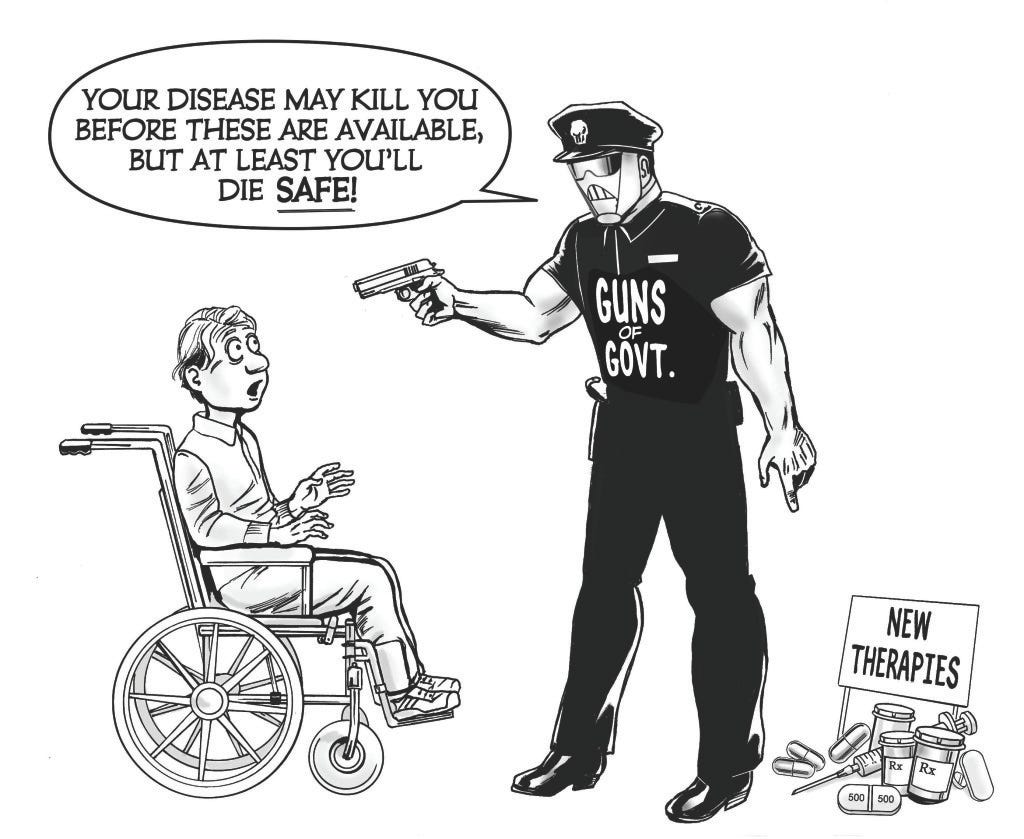

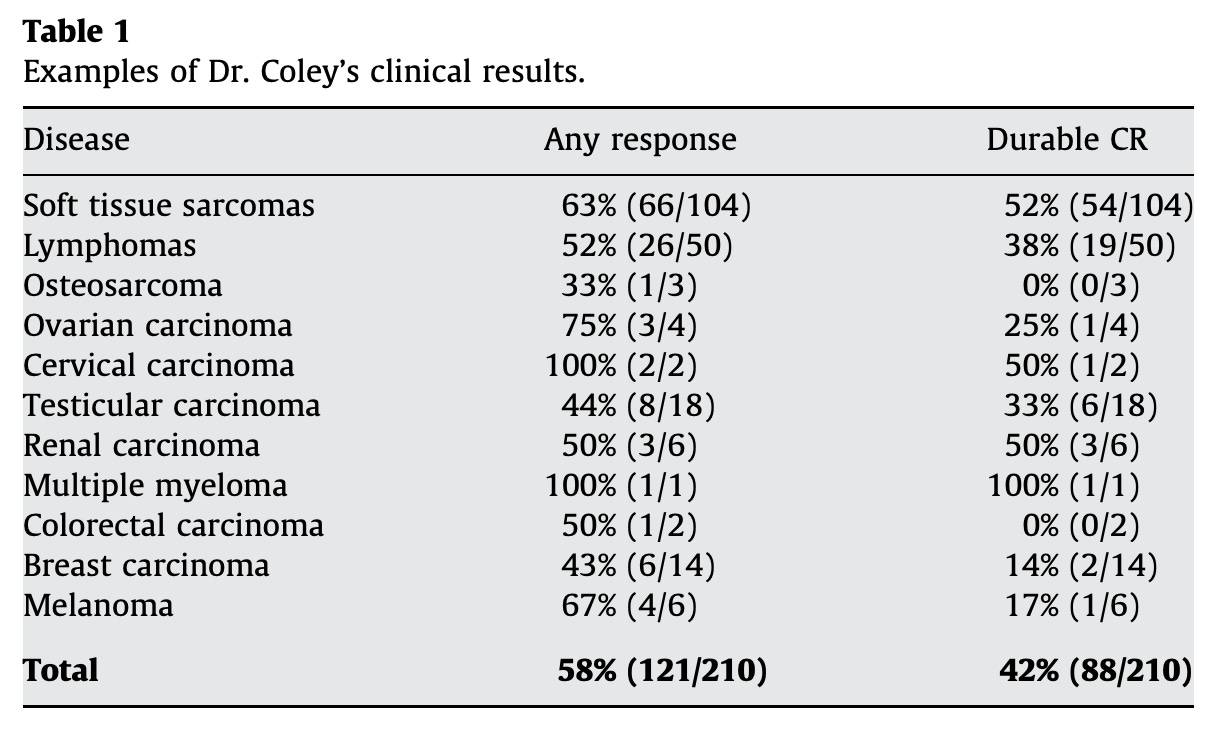
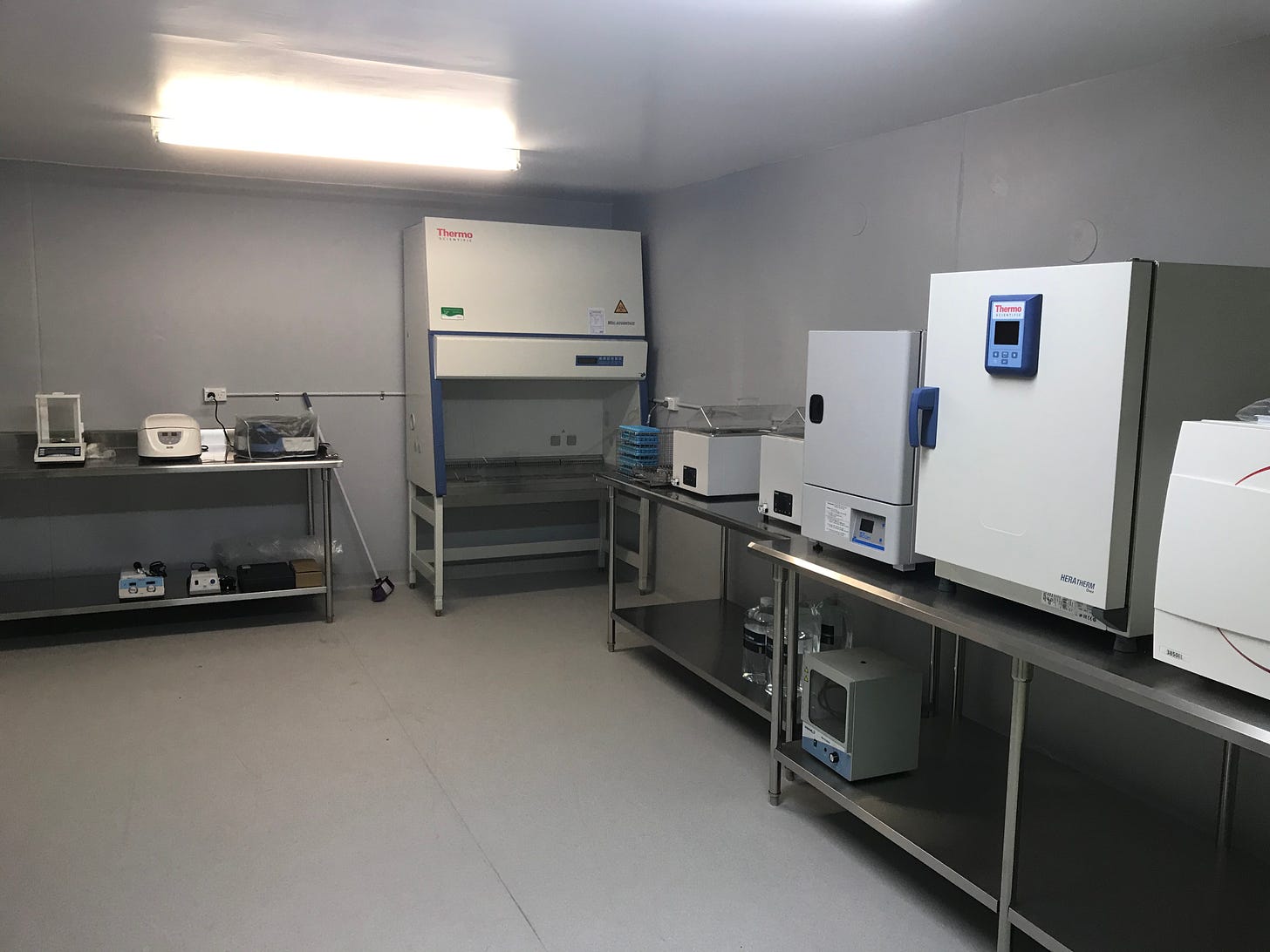



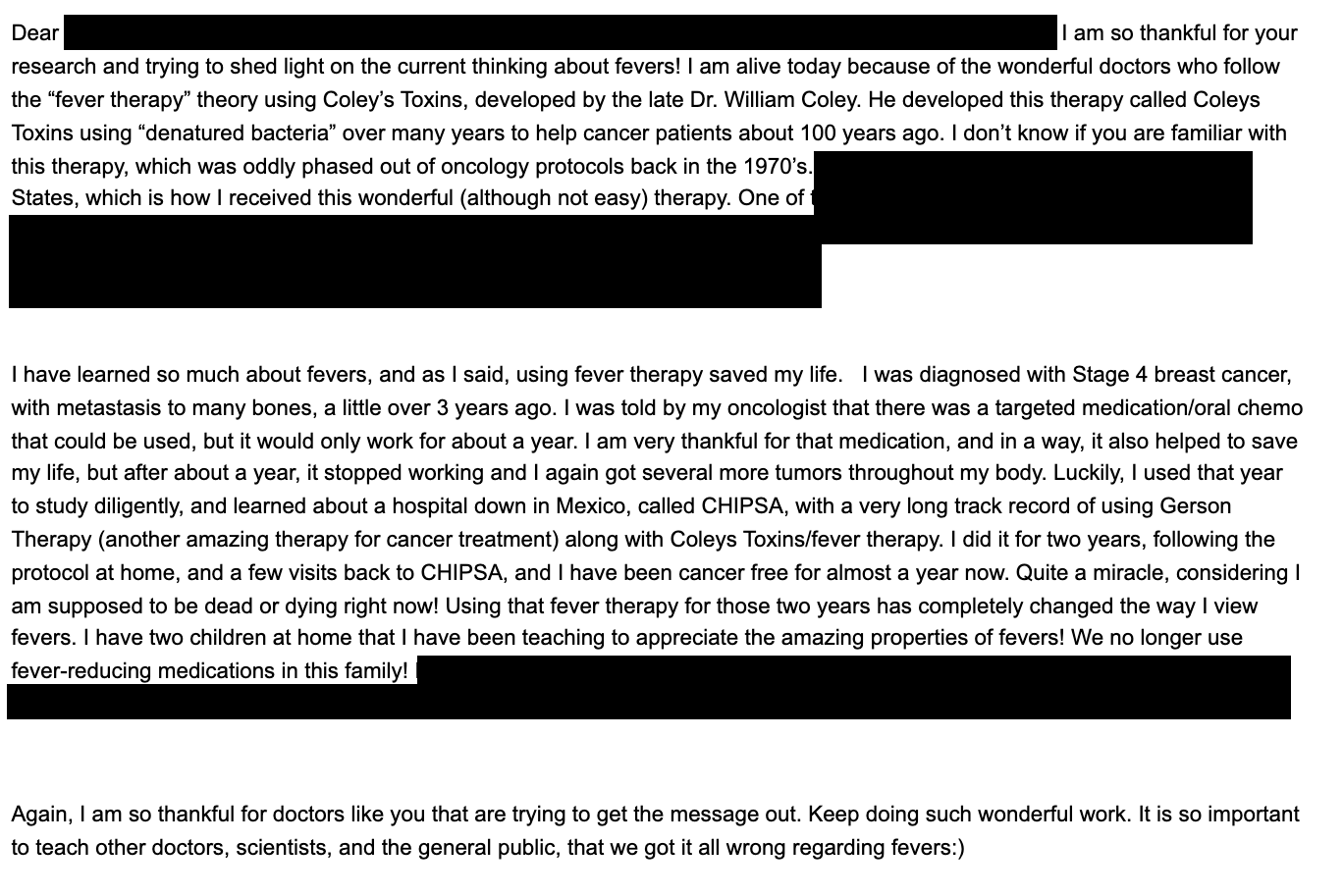
What is it with the obsession against fevers? I don't mean the ones so high it can kill a person, but everything else. I was at a dinner recently with a newly retired nurse and the topic of Tylenol came up - she promotes it and takes it herself for everything, and gave it to patients for decades. Stop fevers, stop pain, stop inflammation - all with Tylenol.
I think there is a big confusion between suppressing symptoms and addressing root causes, and it leads to all sorts of subsequent problems, like preventing anything that may actually cause a fever.
And the best way to stop embedded C Diff that refuses treatment by meds - insertion of healthy poop into the patient. Disgusting mentally but the healthy person's bacterial mix puts the the C Diff swarm in it's place. We hardly understand the biology of our gut.